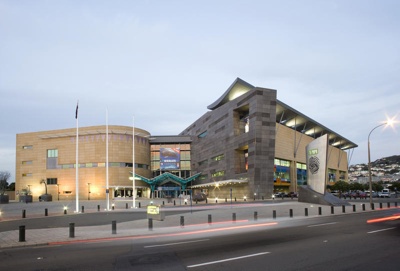Muka Face Mask
Shared by
Museum of New Zealand Te Papa Tongarewa
This is a Muka Face Mask made during the Level 4 Covid-19 rāhui by artist Matthew McIntyre-Wilson (Ngā Mahanga, Titahi, Taranaki). At the start of March 2020, Matthew was in Sydney with a delegation of Māori students and staff from Massey University attending events related to the recently-opened Sydney Biennale. As the impact of the pandemic became more immediate in Aotearoa, the trip was cut short and the delegation returned to Aotearoa to begin a period of self-isolation together. It was at this point that Matthew conceived at began to create the Muka Face Mask. During this period of self-isolation, it was announced that the country was entering into Alert Level 3 for 48 hours before entering Alert Level 4 for four weeks. This was an unprecedented change but illustrates how swiftly the pandemic-related government directives were enacted and these changes are also part of the story that contextualises the making of the Muka Face Mask. The Muka Face Mask is made from almost entirely from aho poka of muka, short wefts that, when woven in a particular way, can mirror the concertina folds of a surgical mask. Matthew mentioned that he first got the idea for using this technique after seeing a surgical mask and believing that the aho poka technique (where there is no introduction or reduction of whenu) can be used to round the face in the same way as a surgical mask. This technique also illustrates a metaphorical link to the kaitaka and pāke and their ability to be used as protection. This is in reference to Ruhia Porutu’s well-known protection of Thomas McKenzie by throwing her kaitaka on him. It also references the impenetrability of pāke after they are submerged in water and their fibres then swelling to fill any gaps. After making the mask, Matthew shared two images of his mask response on his Instagram account. The first was of the work in progress accompanied by an explanation of the weaving technique he was using and where he learned of the technique: “I have an interest in fine muka kākahu created in the 18th century and collected on Captain James Cook’s voyages to New Zealand. There is more to be learnt about the technologies used by Māori makers through making. To be able to study and repatriate the techniques used in these kākahu would be valuable to other makers, weavers and academics in helping to understand more about the complexities of these objects.” Matthew McIntyre Wilson, 2020 A further element of this mask are the taura that will be used to secure the mask. These are woven in a 9-ply braid, some strands of which have been dyed with tanekaha using a cold-brewed technique. The braiding technique itself features two different patterns, which is a reference to kākahu in overseas institutions (including a kaitaka paepaeroa in Edinburgh) where the kaitaka is bordered with braiding rather than tāniko.
Ngā whakamārama
Details
-
Title
Muka Face Mask
-
Maker
Matthew McIntyre-Wilson
-
Date made
2020
-
Subject
muka (fibre), natural dye, tānekaha, fiber masks, maruhā, face masks, whatu aho rua, COVID-19 (Disease), Clothing & dress, illness, Protective clothing, braiding, weaving, Wellington, North Island, New Zealand, Te Huringa III: 1950 - present, Ngā Māhanga, Taranaki, Māori, Matthew McIntyre-Wilson
-
Rights
All Rights Reserved
-
View source record for this item
Kei hea tēnei taonga?
Where is this item held?
-
Additional information including high resolution images may be available.
-
Location
Cable Street, Wellington
-
Website

Whare taonga | Organisation
Museum of New Zealand Te Papa Tongarewa
Ngā here ki runga i ngā whakaahua o tēnei taonga?
What can you do with images of this item?
-
You must check with Museum of New Zealand Te Papa Tongarewa to confirm terms of use and any attribution requirements, but this is our understanding:
-
Use for private study, research, criticism, review, or education
NZ Copyright law allows for the use of copyrighted works in specific circumstances. Consider what you can do under copyright law.
-
No sharing
You can't share this image without futher permission.
-
No modifying
You can't modify, remix or add to this image without further permission.
-
No commercial use
You can't use this image to make money.
-
Text adapted with permission from Te Papa and Digital NZ
Tāpirihia he kōrero anō
Improve this record
-
Can you help us? Share names, details and stories to help enrich the collection.